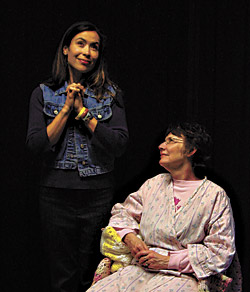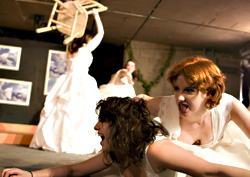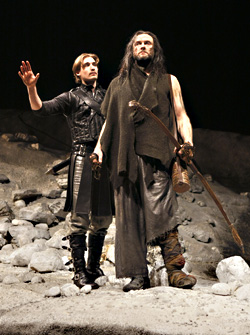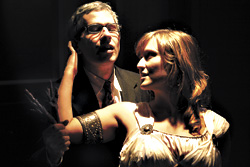“THERE’S SOMETHING about the Pacific Northwest that seems to breed serial killers,” true-crime writer, Spokane radio host, and former O.J. Simpson detective Mark Fuhrman recently told The Associated Press. Now that the D.C. sniper joins fellow former Tacoman Ted Bundy as a suspect in a multiple-murder case, and considering the astounding string of other famous local cases (Spokane’s Robert Yates, British Columbia’s Robert Pickton, Bellingham’s Kenneth Bianchi, Auburn’s Gary Ridgway), it’s hard to suppress the unsettling suspicion that something is very, very weird here. One theory: It’s the water. All those rainy, gloomy skies drove them to it, speculated Fuhrman. Another Fuhrman theory: We have vast forests ideal for stashing bodies. Indeed, Bundy affectionately referred to his local corpse-dump site, where animals helpfully scattered bones that might convict him, as a “self-cleaning oven.”
BUT EXPERT CRIME WRITER and former Bundy friend Ann Rule doubts the Fuhrman theory. “Actually, I don’t think we have more serial killers,” says Rule. “I think that our detectives recognize serial patterns because they’ve had to deal with Bundy, Ridgway, and Yates.” She argues that they’re transients, not truly local. “I think that we attract serial and spree killers because they are—probably subconsciously—looking for a geographical solution to their obsessions. But the obsession with killing goes right along with them, and inevitably they come to land’s end. We are on the sound and the ocean. You will find that many coastal states have a number of high-profile killers ending up there. Georgia, Florida, Texas, California, and Oregon also have more than their share.”
Crime nerds would also classify the sniper as a “spree killer,” not a serial killer in the Ted tradition. “The difference between a spree killer and a serial killer is significant,” cautions Rule. “A spree killer erupts suddenly into a killing rage and kills victims almost every day for about three weeks to a month before he is stopped. He usually ends up a suicide or a suicide-by-cop, i.e.: Christopher Wilder and the guy who shot Versace. They may have killed before, but never in such a bang-bang-bang pattern. They don’t necessarily have a victim type, although sometimes they do. Spree killers tend to travel and zigzag across the country in their monthlong madness. They are usually set off by something that attacks their fragile egos—losing a job, getting turned down by a woman.” (See “Meltdown,” p. 16.)
A serial killer is a different animal, taking a victim or two at a time over a longer period. “As the serial killer becomes more addicted to murder for its own sake, he takes more and more chances and he begins to kill within closer time frames,” says Rule. “In the end, the serial killer acts much like a spree killer because he is out of control, looking for a ‘fix’ every day or so. However, he almost always sticks to his preferred victim type.”
Rule has no doubt about how to classify the Northwest psycho suspect du jour. “I think the current sniper falls neatly into the spree-killer slot. They really have very fragile egos—so they take on the mantle of ‘I am God,’ and love playing games with the police and seeing themselves on TV. Serials often feel this way, too.”
TO ME, THE DISTINCTION ultimately seems academic. Serial killer Ted also zigzagged, from Seattle obscurity to TV stardom in Florida, fancying himself smarter than the cops, courting getting caught, defending himself with a grandiose idiocy that got him killed. When asked to “speculate” on the motive of the killer in the slayings for which he was fried, he cited a hunger for absolute control over another human being and mused, “Some people are just psychologically less ready for failure than others.” That sounds a lot like the accused sniper.
As for the Northwest’s reputation as a psycho-exporting capital, it may have as much to do with fantasy as with fact. Since the 1990s, our immensely influential pop-culture stars have conspired to give us an image as a stronghold of brooding losers and death freaks. In a classic 1991 New York Times essay, Seattleite Tim Egan defined our “stare-at-the-wall weird” regional style as “Northwest Noir.” Locals like David Lynch, Gus Van Sant, and Katherine Dunn depicted an imaginary bizarro world whose artistic excellence, combined with real serial-killer headlines, indelibly identified our damp corner of the country as a place of dark strangeness. Here, Dunn told Egan, “You are allowed to be weird. You are allowed to fail.” And—on-screen at least, from Twin Peaks to Drugstore Cowboy—you were allowed to litter the landscape with beautiful, blue-faced dead women.
AND THIS WAS ALL before Fight Club and grunge! Kurt Cobain’s notebook explicates the significance of the word Nirvana, which means “snuffed out” in Sanskrit: “Ooh eeerie mystical doom.” Sub Pop’s resident philosopher explained to me the significance of the proto-grunge group Green River, named after a regional soda brand, a classic Creedence Clearwater Revival guitar lick, and the serial killer: “So it was the kind of thing like, ‘Yeah, we’re gonna sing songs about chopping up women, but hey, we’re just named after a soda pop.’ They’re menacing and fizzy and bubbly all at the same time.” It was an ominous concoction that sold like crazy and convinced millions that such dark imaginings are our regional brand of culture.
Strictly speaking, the esthetics of Northwest Noir have nothing to do with real-life tragedy. And yet, the root of killing seems to be a twisted form of the creative impulse: the mad fantasies of power dreamed up by serial killers and spree killers alike. They’re Northwest losers, baby. Is that why they kill?








